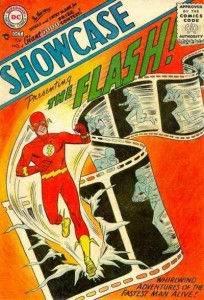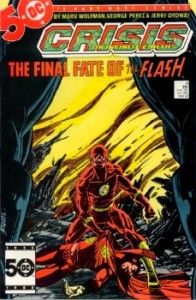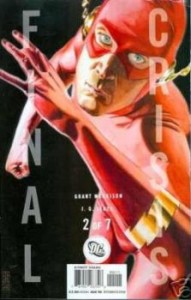An interesting revelation from the latest 20 Questions with Dan Didio at Newsarama. He’s previously claimed (though many fans remained unconvinced) that Bart Allen’s death in Flash: The Fastest Man Alive #13 was planned from the start, but we’ve got a new twist. Here’s part of his answer to question #15:
Bart was always going to go away, and I think the mistake was that we probably pulled Bart a little too soon, but quite honestly again, that was the problem of lining stories up with Countdown. The Bart story was due to be extended a little bit longer, but due to how things were lining up, he had to leave sooner.
That story’s not complete yet. We’re going to see more of what that story was about shortly – it was always the plan for Bart. He was going to be the Flash of the moment as we made our way back to Barry. [emphasis added]
Okay, not a big surprise that they shuffled things around to match with Countdown.* But am I reading that right? Is he saying that they planned to bring Barry Allen back as long ago as Infinite Crisis? Didio continues:
I think Mark Waid did an admirable job of stepping in and trying to find a different slant to Wally and the family, which we found out, was a more difficult story to tell than when we planned it. I think Mark did as best a job as possible – he put so much thought and effort into fleshing out that family, and I think we have a couple of rich characters in the children because of that.
This is the other thing that gets confusing, depending on who tells it: When was the plan made for Wally to return, and when was the plan made for Bart to be killed? Mark Waid’s interview in The Flash Companion suggests that he, at least was led to believe that Bart’s move up to lead Flash was intended to be indefinite, not a fill-in gig, though he predicted it wouldn’t catch on. And Didio’s remarks here about Waid “stepping in” suggest that they did bring him on unexpectedly — though that could simply be the result of moving up the timetable. (Which, now that I think about it, might explain artist Daniel Acuña’s sudden departure.)
I’ll agree with Didio on this: the West Twins are promising characters, even if most of the comics readership seems to want to throw them under a bus.
But at the end of the day, there’s a certain expectation of what a Flash story is, and what you want to see in a Flash comic book. While we expanded the Flash family, people really wanted to see the Flash.
And that seems to have been the main criticism of issues #231–243: Not enough of the Flash in The Flash.
But the goal for me, always, was to get back to Barry in the same way the goal was to get back to Hal in Green Lantern.
Whoa, hold on a second. Now he is saying that they were planning to bring Barry back from the beginning?
Well why didn’t they do that in the first place?
Seriously, Infinite Crisis would have been a perfect time to bring Barry back. Sure, a lot of us would have been pissed off that they were getting rid of Wally just because it was a Crisis and going back to Barry just so that they could bring back the guy who was the Flash when they were twelve — but you know what, we’re pissed off anyway. Plus we’ve got the frustration of three years of mismanaged Flash stories on top of that.
So, to sum up: DC considered Bart as a temp from the beginning. And DC never had any intention of bringing Wally back after they kicked Bart out, at least not as the primary Flash. It was all about Barry from the start.
*I find it amusing — in a banging-my-head-against-the-wall way — that people were so annoyed with the way some stories were stretched out during Countdown for the sake of lining books up, and people are annoyed now with Final Crisis because they’re not trying to line everything up.

 Barry made his debut in the 1956 comic book,
Barry made his debut in the 1956 comic book, 
 Another year later, with Final Crisis looming and continuing discontent with the relaunch, fans started to see clues that, once again, hinted at a possible return for Barry. Among those clues was a poster that appeared at the New York Comic Con that looked a lot like Barry — and was painted by J.G. Jones, the artist on Final Crisis. Then there was the summary for Final Crisis #2 and its “spectacular return from the dead.”
Another year later, with Final Crisis looming and continuing discontent with the relaunch, fans started to see clues that, once again, hinted at a possible return for Barry. Among those clues was a poster that appeared at the New York Comic Con that looked a lot like Barry — and was painted by J.G. Jones, the artist on Final Crisis. Then there was the summary for Final Crisis #2 and its “spectacular return from the dead.”